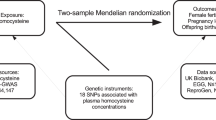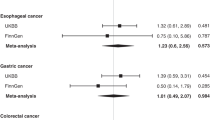Abstract
Background/Objectives:
Folate has been recognized to ensure reproductive health and there is a growing body of epidemiological evidence suggesting that the methylenetetrahydrofolate reductase (MTHFR) 677T allele and reduced dietary folate may increase the risk of cervical cancer. The main focus of our survey was to investigate the distribution of the MTHFR C677T polymorphism in relation to women's year of birth and to assess their folate intake and folic acid supplementation.
Subjects/Methods:
During a 6-months period, 307 healthy women of childbearing age in Catania, Italy, were enrolled in the cross-sectional study. Folate intake was estimated by a semiquantitative food frequency questionnaire and DNA extracted from blood samples for MTHFR C677T genotyping.
Results:
A TT genotype frequency of 20.5% with an increase in the prevalence of the TT genotype in the cohort of women born since 1959 was shown. The prevalence of inadequate folate intake was 51.5%, significantly higher in non-pregnant women (83.4%) than in pregnant ones (12.3%) with a decrease during the three trimesters of pregnancy (from 25.7 to 5.0%; P=0.013). The use of folic acid supplements improved during the three trimester of pregnancy (from 71.4 to 95.0%; P=0.001).
Conclusions:
Healthy young women may have higher folate needs due to increasing prevalence of the T allele and reduced folate intake compared with older groups. However, clinicians should be cautious when recommending supplements to women in late pregnancy due to the possible implications in the pregnancy outcome.
This is a preview of subscription content, access via your institution
Access options
Subscribe to this journal
Receive 12 print issues and online access
$259.00 per year
only $21.58 per issue
Buy this article
- Purchase on Springer Link
- Instant access to full article PDF
Prices may be subject to local taxes which are calculated during checkout
Similar content being viewed by others
References
Agodi A, Barchitta M, Cipresso R, Marzagalli R, La Rosa N, Caruso M et al. (2010). Distribution of p53, GST and MTHFR polymorphisms and risk of cervical intraepithelial lesions in Sicily. Int J Gynecol Cancer 20, 141–146.
Alwan N, Greenwood D, Simpson N, McArdle H, Cade J (2010). The relationship between dietary supplement use in late pregnancy and birth outcomes: a cohort study in British women. BJOG 117, 821–829.
Erkkola M, Karppinen M, Javanainen J, Räsänen L, Knip M, Virtanen SM (2001). Validity and reproducibility of a food frequency questionnaire for pregnant Finnish women. Am J Epidemiol 154, 466–476.
Flatley JE, McNeir K, Balasubramani L, Tidy J, Stuart EL, Young TA et al. (2009). Folate status and aberrant DNA methylation are associated with HPV infection and cervical pathogenesis. Cancer Epidemiol Biomarkers Prev 18, 2782–2789.
Flood VM, Smith WT, Webb KL, Mitchell P (2004). Issues in assessing the validity of nutrient data obtained from a food-frequency questionnaire: folate and vitamin B12 examples. Public Health Nutr 7, 751–756.
Food and Nutrition Board, Institute of Medicine (2001). Dietary Reference Intakes. National Academy Press: Washington, DC.
French MR, Langdon C, Levy-Milne R (2001). Development of a validated food frequency questionnaire to determine folate intake. Can J Diet Pract Res 62, 82–86.
Garcia-Closas R, Castellsague X, Bosch X, Gonzalez CA (2005). The role of diet and nutrition in cervical carcinogenesis: a review of recent evidence. Int J Cancer 117, 629–637.
Goodman MT, McDuffie K, Hernandez B, Wilkens LR, Bertram CC, Killeen J et al. (2001). Association of methylenetetrahydrofolate reductase polymorphism C677T and dietary folate with the risk of cervical dysplasia. Cancer Epidemiol Biomark Prev 10, 1275–1280.
Guéant-Rodriguez RM, Guéant JL, Debard R, Thirion S, Hong LX, Bronowicki JP et al. (2006). Prevalence of methylenetetrahydrofolate reductase 677T and 1298C alleles and folate status: a comparative study in Mexican, West African, and European populations. Am J Clin Nutr 83, 701–707.
Henao OL, Piyathilake CJ, Waterbor JW, Johanning GJ, Heimburger DC, Funkhouser E et al. (2005). Women with polymorphisms of methylenetetrahydrofolate reductase (MTHFR) and methionine synthase (MS) are less likely to have cervical intraepithelial neoplasia (CIN) 2 or 3. Int J Cancer 113, 991–997.
International Clearinghouse for Birth Defects Monitoring Systems. Annual Report 2001. International Centre for Birth Defects: Rome 2001.
Jenab M, Slimani N, Bictash M, Ferrari P, Bingham SA (2009). Biomarkers in nutritional epidemiology: applications, needs and new horizons. Hum Genet 125, 507–525.
Johansson I, Van Guelpen B, Hultdin J, Johansson M, Hallmans G, Stattin P (2010). Validity of food frequency questionnaire estimated intakes of folate and other B vitamins in a region without folic acid fortification. Eur J Clin Nutr 64, 905–913.
Kristal AR, Potter JD (2006). Not the time to abandon the food frequency questionnaire: counterpoint. Cancer Epidemiol Biomarkers Prev 15, 1759–1760.
Mayor-Olea A, Callejón G, Palomares AR, Jiménez AJ, Gaitán MJ, Rodríguez A et al. (2008). Human genetic selection on the MTHFR 677C>T polymorphism. BMC Med Gen 9, 104.
Munoz-Moran E, Dieguez-Lucena JL, Fernandez-Arcas N, Peran-Mesa S, Reyes-Engel A (1998). Genetic selection and folic acid intake during pregnancy. Lancet 352, 1120–1121.
Ortiz-Andrellucchi A, Doreste-Alonso J, Henrỳquez-Sanchez P, Cetin I, Serra-Majem L (2009). Dietary assessment methods for micronutrient intake in pregnant women: a systematic review. Brit J Nutr 102, S64–S86.
Piyathilake CJ, Henao OL, Macaluso M, Cornwell PE, Meleth S, Heimburger DC et al. (2004). Folate is associated with the natural history of highrisk human papillomaviruses. Cancer Res 64, 8788–8793.
Piyathilake CJ, Macaluso M, Brill I, Partridge EE, Heimburger DC (2007). Lower red blood cell folate enhances the HPV 16-associated risk of cervical intraepithelial neoplasia. Nutrition 23, 203–210.
Piyathilake CJ, Macaluso M, Alvarez RD, Bell WC, Heimburger DC, Partridge EE (2009). Lower risk of cervical intraepithelial neoplasia in women with high plasma folate and sufficient vitamin B12 in the post-folic acid fortification era. Cancer Prev Res 2, 658–664.
Rosenberg N, Murata M, Ikeda Y, Opare-Sem O, Zivelin A, Geffen E et al. (2002). The frequent 5,10-methylenetetrahydrofolate reductase C677T polymorphism is associated with a common haplotype in whites, Japanese, and Africans. Am J Hum Genet 70, 758–762.
Tamura T, Picciano MF (2006). Folate and human reproduction. Am J Clin Nutr 83, 993–1016.
Wilcken B, Bamforth F, Li Z, Zhu H, Ritvanen A, Renlund M et al. (2003). Geographical and ethnic variation of the 677C>T allele of 5,10 methylenetetrahydrofolate reductase (MTHFR): findings from over 7000 newborns from 16 areas worldwide. J Med Genet 40, 619–625.
Willett WC, Hu FB (2007). The food frequency questionnaire. Cancer Epidemiol Biomarkers Prev 16, 182–183.
World Health Organization (1995). Physical status: the use and interpretation of anthropometry. Report of a WHO Expert Committee. World Health Organ Tech Rep Ser 854, 1–452.
Zetterberg H (2004). Methylenetetrahydrofolate reductase and transcobalamin genetic polymorphisms in human spontaneous abortion: biological and clinical implications. Reprod Biol Endocrinol 2, 7.
Acknowledgements
This work was supported in part by grants from the University of Catania (Progetti di Ricerca di Ateneo to AA).
Author information
Authors and Affiliations
Corresponding author
Ethics declarations
Competing interests
The authors declare no conflict of interest.
Rights and permissions
About this article
Cite this article
Agodi, A., Barchitta, M., Valenti, G. et al. Increase in the prevalence of the MTHFR 677 TT polymorphism in women born since 1959: potential implications for folate requirements. Eur J Clin Nutr 65, 1302–1308 (2011). https://doi.org/10.1038/ejcn.2011.125
Received:
Revised:
Accepted:
Published:
Issue Date:
DOI: https://doi.org/10.1038/ejcn.2011.125
Keywords
This article is cited by
-
Adherence to the Mediterranean diet partially mediates socioeconomic differences in leukocyte LINE-1 methylation: evidence from a cross-sectional study in Italian women
Scientific Reports (2020)
-
The association between MTHFR polymorphism and cervical cancer
Scientific Reports (2018)
-
Low fruit consumption and folate deficiency are associated with LINE-1 hypomethylation in women of a cancer-free population
Genes & Nutrition (2015)



